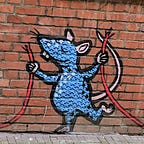Meat Me Halfway
I became a vegetarian my sophomore year of college. For my last meal of animal flesh, my roommate and I rode the subway to Coney Island and treated ourselves to Nathan’s hot dogs.
Veganism didn’t exist then (at least by that name) so vegetarianism was the most radical statement you could make with your diet. I was called on it often, especially by my elders, many of whom didn’t go a meal without meat. I gave them a lengthy explanation for my decision, roughly in this order: meat sat in my gut for days and made me feel logy; a pound of pinto beans cost considerably less than a pound of steak and provided many more wholesome meals; humans have a long history of dietary discipline, such as keeping kosher or halal, and vegetarianism is in that tradition; I don’t need to eat animals to survive and want to reduce the suffering I cause other sentient beings; and, last but not least, meat production is bad for the environment, contributing to climate change and degrading the landscape.
That usually ended the discussion, although it didn’t persuade anyone to join me.
How little has changed. Last week the right-wing lie machine propagated the whopper (pun intended) that Joe Biden is plotting to limit Americans to four pounds of red meat a year. From the outrage (“No burger on July 4,” whined one former Trump appointee) you would have thought Biden spat on the flag.
But here’s the irony: per capita meat consumption may indeed plummet to nearly nothing over the next few years, due not to government edict but market forces. The same disruption (or creative destruction — pick your euphemism) that Fox and Fiends cheered when it ruined the newspaper industry, the taxicab industry, etc., is now coming for the meat industry.
Have you tried an Impossible Burger yet? I did, before the pandemic. I’m not one of those vegetarians who misses meat, but we went with members of The Fabulous Wife’s family to a downtown Berkeley restaurant that served Impossible Foods products, and I was dared to try a burger. It looks like a meat burger. It has the color and texture of a meat burger. And it tastes like — well, after forty years I don’t remember what meat tastes like. But it sure didn’t taste like those fakey soy burgers we’ve choked down over the years. The Impossible Burger is totally convincing, so much so that I considered the possibility I’d been tricked into eating genuine meat. My stomach flipped a couple of times in horror, heedless of my pleas that it accept those globs of medium rare plant protein as safe.
Investors are betting on fake meat for all the reasons I became a vegetarian, including the last one (the environment): according to Impossible Foods’ CEO, an Impossible Burger requires 96% less land, 87% less water, and creates 89% fewer greenhouse gases than a meat burger. But the clinching argument is that the products are virtually indistinguishable from real meat. That’s driving so much demand that even Nathan’s is getting in the spirit.
I’m sure the people terrified of being limited to four pounds of red meat a year will continue to perceive fake meat as a threat to their way of life, even though it’s superior to real meat in every respect: cheaper, healthier, and cruelty-free on top of eco-friendly. But their approval isn’t necessary. If just half the population switches to fake meat, industrial meat producers will become as obsolete as icemen.
But the ketchup and pickle industries should prosper, if only because I’ll need tons of both to overcome that disconnect between appearance and reality.
